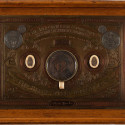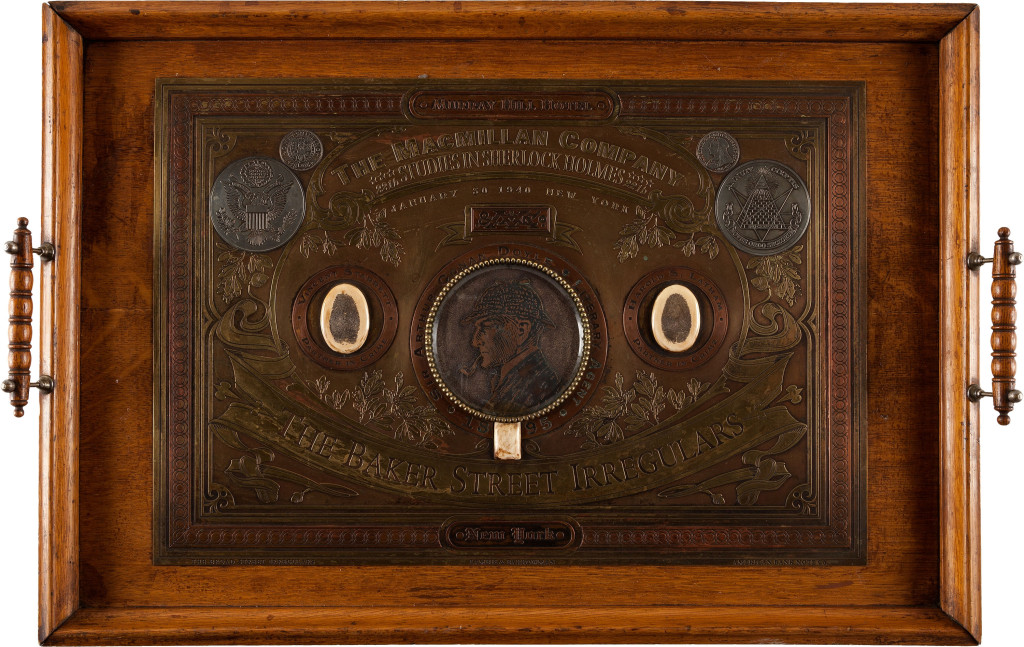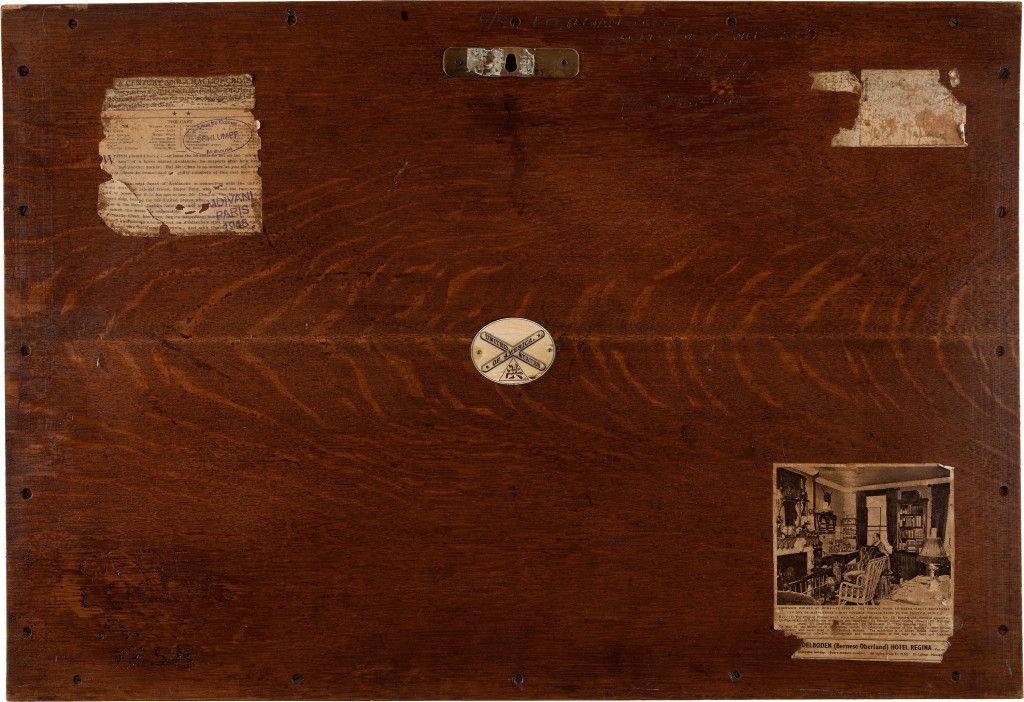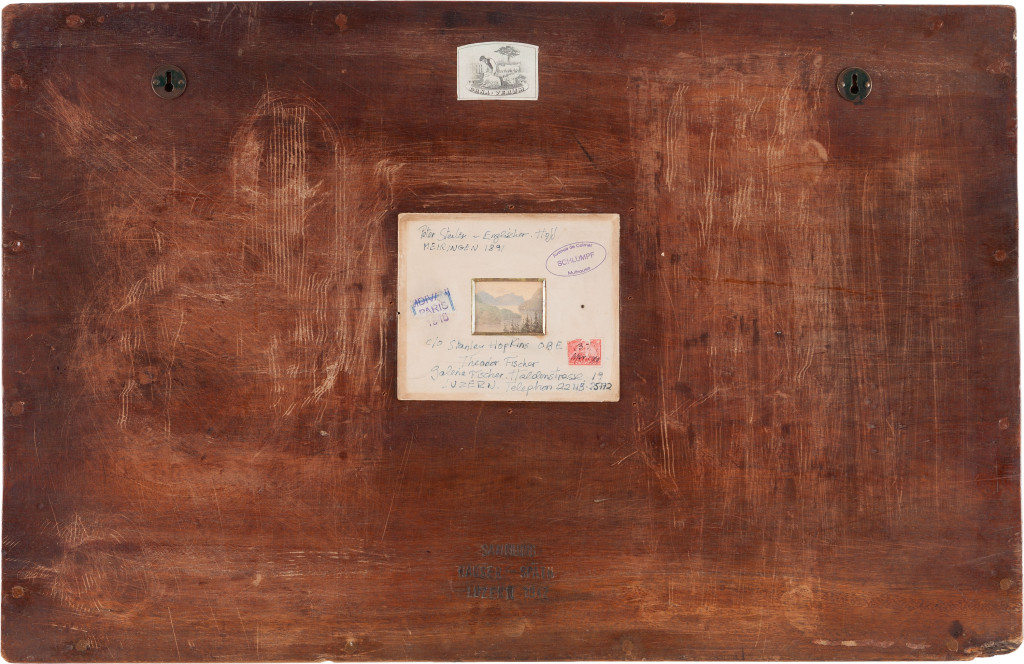A Scion Society of The Baker Street Irregulars

Heritage Auctions’ October 8, 2014 Auction Lot Descriptions of Two Irregular Plates
“Well, really, this is a very pretty little mystery!”
– The Sign of The Four (SIGN)

LOT 45316 – Original Brass Plate Mounted to a Dinner Tray Celebrating Sherlock Holmes and the … – Heritage Auctions October 8, 2014 Rare Book Sale, Beverly Hills
[Sir Arthur Conan Doyle & Sherlock Holmes]. Original Brass Plate Mounted to a Dinner Tray Celebrating Sherlock Holmes and the Publication of Vincent Starrett’s 221B: Studies in Sherlock Holmes. A companion to the plaque-mounted plate (together two of three total plates known-the third, another tray, appeared in a 2013 auction) and commemorating the publication party for Starrett’s then newly-printed anthology of Holmes-related writings hosted by the Baker Street Irregulars at the Murray Hill Hotel in New York on January 30, 1940. According to Jon Lellenberg’s January 2014 article “The Mystery of the Three Irregular Plates,” This tray is not mentioned in the minutes of the dinner taken by Edgar W. Smith; therefore, it was almost certainly not presented to Starrett at that time, only further obscuring its origin.The dinner tray on which the plate is mounted is likely made of oak and measures approximately 18.25 x 26.5 inches, with brass and wood handles at each end. The plate design compliments its counterpart, with Holmes’s profile, after a popular drawing by Frederic Dorr Steele, centered in magnifying glass device, with the engraved thumbprints of “Partners in Crime” Vincent Starrett and Harold S. Latham (trade editor at Macmillan) on either side. Reliefs of The Great Seal of the United States and the Annuit Cœptis seal found on the reverse of the United States one-dollar bill are at the upper corners next to the inlaid obverse and reverse of an 1895 Victoria shilling. At the upper center “The Macmillan Company / 221b Studies in Sherlock Holmes 221b / January 30 1940 New York” and “The Baker Street Irregulars” is under Holmes’s profile. Engraved along the bottom edge is “The Broad Street Irregulars – Lambie & Barrowman – American Bank Note Co.”

On the tray’s reverse there is a mounted oval wooden label marked “United States of America” with an Asian character enclosed in a triangle beneath it. Additionally, three items are pasted to corners: a partial review of Charlie Chan at the Race Track rubber stamped “Avenue de Colmar / Schlumpf / Mulhouse,” a newspaper photo of a recreation of the interior of 221b Baker Street with brief description, and a label with barely legible holographic pencil notations. Some additional text carved directly into the wood. Small brass mount to upper center.
The tray has maintained an overall very nice appearance, and remains in near fine condition with only a small handful of minor blemishes and slight separation of two sidewalls at joints.
This plate and its companion in Lot 45317, at a cursory glance, are but seemingly simple relics to celebrate Starrett’s publication of 221B: Studies in Sherlock Holmes (1940) and the Baker Street Irregulars (BSI) of the early 1940s, but after closer observation, several important associations with the BSI can be made (with referencing the bsiarchivalhistory.org website and the research of Jon Lellenberg). The legend at the bottom left of each plate, “The Broad Street Irregulars” refers to the address of the offices of the American Bank Note Co. (whose name appears at the bottom right), the evident manufacturer of both plates. Their involvement was, no doubt, due to the fact that one of their executives, Allan Murray Price (whose name appears on one of the central medallions on the July 11 plate), was an early member of BSI, who had once submitted a “near perfect” solution to Frank Morley’s Sherlock Holmes Crossword, earning him a place at the first formal meeting and later the first formal dinner of the BSI, both in 1934. On the reverse of each, there is the rubber stamp “MDIVANI PARIS 1948,” indicating the one-time ownership of Denis Conan-Doyle, one of the sons of Sir Arthur (who had married the Georgian pretend-princess Nina Mdivani, but that’s another story). There is a curious legend in the bottom-center of the plates: “Lambie & Barrowman;” this seems to refer to key witnesses in the 1909 controversial Oscar Slater murder case: Helen Lambie and Mary Barrowman, which Sir Arthur followed closely (he, like many people were convinced of Slater’s innocence and of the corrupted nature of his trial, and even wrote The Case of Oscar Slater in 1912, pleading for Slater’s pardon – Slater had his conviction thrown out and was freed in 1928). Why these two earned mention is an actual mystery, and the overall mystery regarding when and why these plates were produced lingers on, perhaps never to be deduced. Reference: Jon Lellenberg, “The Mystery of the Three Irregular Plates,” in The Saturday Review of Literature, January 18, 2014.

LOT 45317 – Original Brass Plate Mounted to Plaque Celebrating Sherlock Holmes and the Publica…
The Rare Companion Plate to the Baker Street Irregulars Plaque
[Sir Arthur Conan Doyle & Sherlock Holmes]. Original Brass Plate Mounted to Plaque Celebrating Sherlock Holmes and the Publication of Vincent Starrett’s 221B: Studies in Sherlock Holmes. Perhaps presented to Vincent Starrett at a publisher’s(?) event in Toronto on July 11, 1940, on the occasion of the publication of Starrett’s 221B – Studies in Sherlock Holmes (perhaps celebrating the Canadian publication or as a delayed congratulations after the BSI Dinner that year, which was held on January 30, 1940 and was the publication party for Starrett’s book).
The plate is mounted to a walnut board and measures approximately 19.5 x 29.5 inches. The plate design follows the same currency motif of its New York predecessor featuring the same reliefs of The Great Seal of the United States and the Annuit Cœptis, with six 1895 Victoria shillings inlaid. Centered on the plate is an engraving of Holmes in profile after the popular drawing by Frederic Dorr Steele in a magnifying glass device surrounded by words “Sir Arthur Conan Doyle Literary Agent 1895.” At the upper center is “The Baker Street Irregulars / The Macmillan Company / Studies in Sherlock Holmes / January 30 1940” with “221 B” on either side of the date. Surrounding the central Holmes figure are eight radiating lines, four per side, bearing the fancifully named dishes served at the BSI dinner such as Ice Cream and Petit Signs of Four. Further there is a larger medallion of Queen Victoria below the Holmes profile and two engraved fingerprints at the extreme right and left, though unlabeled, likely belonging to Starrett and his editor at Macmillan Harold S. Lantham, the “Partners in Crime” of the January 1940 plate. Mounted directly to the board beneath the plate is the label “With the Compliments of / The Macmillan Co. / 11 July 1940, Toronto.”

On the reverse of the plaque is a square section of heavy cardboard measuring 6.5 x 5.5 inches, with a central watercolor showing through a beveled opening. There are numerous stamps and notes. It seems to have been addressed like a letter: “C/o Stanley Hopkins OBE / Theodore Fischer / Galerie Fischer [a Swiss auction house] Haldenstrasse 19 / Luzern / Telephone 2211325772.” This ties in with the Sherlock Holmes theme as Stanley Hopkins OBE appeared in “Mrs. Hudson Speaks” with Zazu Pitts. Also Stanley Hopkins appears in many of the stories, rising in rank from Chief Inspector to Superintendent to Assistant Commissioner. The reference here could mean that Theodore Fischer assumed the moniker of “Stanley Hopkins OBE” as his Sherlockian nickname, a common practice among the more serious devotees of the Great Detective. Or, as according to BSI historian, Jon Lellenberg recently posited in his January 18, 2014 article in The Saturday Review of Literature, the Hopkins reference could be a direct tie to Christopher Morley, “who used that circumlocution occasionally for remarks of his own in his ‘Clinical Notes of a Resident Patient’ column in the Original Series BSJ in the latter 1940s.” As a side note: it is also bears mention from Mr. Lellenberg’s article that this plate was almost assuredly not presented to Starrett AT the BSI Dinner (or in time for the dinner), since such an event would have certainly been mentioned by Edgar W. Smith in his minutes from the dinner.The plaque remains in very good condition with a small crack to glass at the bottom of the magnifying glass, some scant peeling at edges of ribbon devices. Border detached but present with original nails missing. Negligible chipping to board corners with some minor scuffs to margins, still a very presentable unique Holmesiana artifact.
This plate and its companion in Lot 45316, at a cursory glance, are but seemingly simple relics to celebrate Starrett’s publication of 221B: Studies in Sherlock Holmes (1940) and the Baker Street Irregulars (BSI) of the early 1940s, but after closer observation, several important associations with the BSI can be made (with referencing the bsiarchivalhistory.org website and the research of Jon Lellenberg). The legend at the bottom left of each plate, “The Broad Street Irregulars” refers to the address of the offices of the American Bank Note Co. (whose name appears at the bottom right), the evident manufacturer of both plates. Their involvement was, no doubt, due to the fact that one of their executives, Allan Murray Price (whose name appears on one of the central medallions on the July 11 plate), was an early member of BSI, who had once submitted a “near perfect” solution to Frank Morley’s Sherlock Holmes Crossword, earning him a place at the first formal meeting and later the first formal dinner of the BSI, both in 1934. On the reverse of each, there is the rubber stamp “MDIVANI PARIS 1948,” indicating the one-time ownership of Denis Conan-Doyle, one of the sons of Sir Arthur (who had married the Georgian pretend-princess Nina Mdivani, but that’s another story). There is a curious legend in the bottom-center of the plates: “Lambie & Barrowman;” this seems to refer to key witnesses in the 1909 controversial Oscar Slater murder case: Helen Lambie and Mary Barrowman, which Sir Arthur followed closely (he, like many people were convinced of Slater’s innocence and of the corrupted nature of his trial, and even wrote The Case of Oscar Slater in 1912, pleading for Slater’s pardon – Slater had his conviction thrown out and was freed in 1928). Why these two earned mention is an actual mystery, and the overall mystery regarding when and why these plates were produced lingers on, perhaps never to be deduced. Reference: Jon Lellenberg, “The Mystery of the Three Irregular Plates,” in The Saturday Review of Literature, January 18, 2014.
Service and Handling Description: Framed – with Glass, Medium

This post was mentioned on page 4 of the April 2016 issue of Scuttlebutt from the Spermaceti Press, which can be viewed at http://redcircledc.org/assets/files/Spermaceti/scuttlebutt-2016.pdf